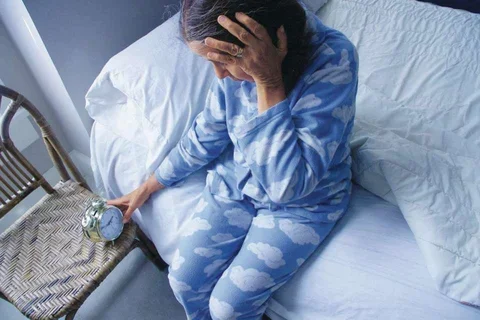Voice response time offers new way to measure sleepiness in older adults
CTSI-supported study reveals that verbal reaction time may help identify excessive sleepiness in older adults using sedative medications

A UCLA-led research team has uncovered a subtle way to measure sleepiness in adults: how quickly they start speaking after hearing a verbal prompt, also known as their Verbal Reaction Time (VRT). By measuring VRT through a mobile app, the researchers found through a voice signaling analysis that they could identify excessive sleepiness, particularly in adults over the age of 55 using sedative medications.
Sleepiness is an often-overlooked risk that can have dangerous consequences. It can negatively impact an individual’s alertness or decision-making skills, contributing to issues such as car accidents, memory and cognitive decline and an increase in falls and injuries. This is particularly the case for older adults. Older adults actively taking benzodiazepine receptor agonists (BZRAs) are at even higher risk, as their sleepiness can often fly under the radar, especially because traditional tests made to measure sleepiness can be intrusive or impractical for everyday settings.
BZRAs are a class of medications commonly prescribed to treat insomnia and anxiety, and include drugs like zolpidem (Ambien) and temazepam. While these sedative medications can help people fall asleep faster, their effectiveness can fade with regular use and can increase risks of drowsiness, memory issues, and falls and car accidents.
The research team enlisted study participants with insomnia, aged 55 years or older, and with a history of BZRA use. In particular, the participants were part of a BZRA deprescribing trial, meaning that they were in the process of tapering off of sleep medications. Each participant was asked to complete memory tests through a convenient app that recorded their verbal responses. By specifically measuring the delay between the prompt and the participant’s first spoken word, the research team was able to gain insight into each person’s alertness level.
By using the voice recordings, the study team compared VRT with individual’s perceived sleepiness gathered from self-reported sleepiness scales. The team then used advanced modeling techniques to examine the relationship between VRT and sleepiness, while controlling for factors like age, sex and medication status. Ultimately, longer VRTs were linked to greater self-reported sleepiness, suggesting that simple voice tests might offer a simple and scalable solution to tracking and measuring sleepiness.
“This study shows that something as simple as how quickly someone starts speaking can tell us a lot about their level of alertness,” said Tue T. Te, MD, MPH, MS, HS clinical instructor in the department of medicine at David Geffen School of Medicine at UCLA and the VA Greater Los Angeles Healthcare System. “It opens the door to using voice as a passive, scalable tool for monitoring sleepiness during everyday activities.” Also featured on the study are CTSI program leads, Alex Bui, PhD and Arash Naeim, MD, who both co-lead the Network Capacity Program at the UCLA CTSI. Dr. Bui also serves as program lead of the Biomedical Informatics Program and director of the TL1 program, while Dr. Naeim is the co-director of the UCLA CTSI and leader of the Clinical Interactions and Regulatory Knowledge and Support programs.
The CTSI supported the parent trial for the study in several ways, which include:
- Extracting a list of names from the data warehouse for the study team to use for recruitment for the parent trial
- Providing the study team with access to and support for REDCap, which was used to prompt patients to perform the mobile cognitive tests and to obtain ecological momentary assessments
- Providing access to clinical research coordinators who recruited for the parent trial, from which the team recruited for this supplemental study
- Providing a letter of support for the initial NIH grant application
In regard to next steps, the study team hopes to broaden this method by applying it to larger, more varied groups and examining how it could be integrated into routine tools such as smartphones and telehealth services. Upcoming studies may also delve into the potential of voice-based indicators to track the impact of medications or identify early cognitive changes.
Read the full study published in Sleep Science and Practice.
Photo source: UCLA Health
Photo caption: Woman checks alarm clock in bed